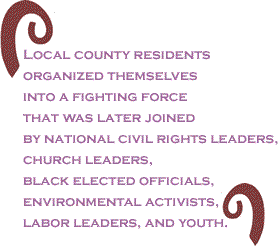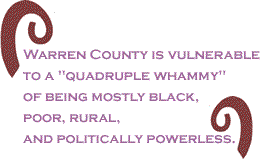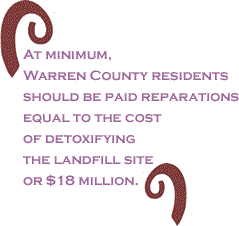
|
|||||||||||||||||||||
|
The following article was originally published by the Environmental Justice Resource Center at at Clark Atlanta University. After waiting more than two decades, an environmental justice victory finally came to the residents of predominately black Warren County, North Carolina. Since 1982, county residents lived with the legacy of a 142-acre toxic waste dump. Detoxification work began on the dump in June 2001 and the last clean-up work was slated to end the latter part of December 2003. State and federal sources spent $18 million to detoxify or neutralize contaminated soil stored at the Warren County PCB landfill. A private contractor hired by the state dug up and burned 81,500 tons of oil-laced soil in a kiln that reached more than 800-degrees Fahrenheit to remove the PCBs (polychlorinated biphenyls). The soil was put back in a football-size pit, re-covered to form a mound, graded, and seeded with grass. Local Warren County environmental justice leaders and their allies across the state deserve a gold medal for not giving up the long fight and pressuring government officials to keep their promise and clean up the mess they created. This was no small feat given state deficits, budget cuts, and past broken promises. Residents and officials now must grapple with what to do with the site. This decision will not be an easy one to make nor is it likely to be absent of controversy. Justice Delayed and Justice Denied The sign at the entrance to the Warren County PCB landfill reads, "PCB Landfill – No Trespassing." Clearly, the phrase "Justice Delayed is Justice Denied" might be more appropriate for a new sign at the entrance to the landfill. The landfill was constructed to contain 40,000 cubic yards (or 60,000 tons) of highly PCB-contaminated soil that was scraped up from 210 miles of roadside shoulders in North Carolina. The PCBs originated from the Raleigh-based Ward Transfer Company. A Jamestown, New York, trucking operation owned by Robert J. Burns obtained PCB-laced oil from the Ward Transfer Company for resale. Faced with economic loss as a result of the U.S. Environmental Protection Agency (EPA) ban on resale of the toxic oil, the waste hauler chose the cheap way out by illegally dumping it along North Carolina roadways.
Between June 1978 and August 1978, over 30,000 gallons of waste transformer oil contaminated with PCBs were illegally discharged on roadside in fourteen counties. The PCBs resulted in the U.S. EPA designating the roadsides as a superfund site to protect public health. The controversial PCB landfill is owned by the North Carolina Department of Environment and Natural Resources (DENR) and is located about 60 miles northeast of Raleigh off North Carolina SR 1604 and U.S Highway 401. The toxic-waste dump was forced on the tiny Afton community – more than 84 percent of the community was black in 1982 – helping trigger the national environmental justice movement. While the ‘mid-night dumpers" were fined and jailed, the innocent Afton community was handed a 20-year sentence of living in a toxic-waste prison. Symbol of a National Movement After months of deliberations and a questionable site selection exercise, North Carolina Governor James B. Hunt decided to bury the contaminated soil in the community of Afton located in Warren County. This rural county might seem an unlikely spot to give birth to a global movement. Local citizens later tagged the landfill "Hunts Dump." Warren County put environmental racism on the map. The PCB landfill later became the most recognized symbol in the county. Despite the stigma, Warren County also became a symbol of the environmental justice movement. Warren County residents did not take kindly of having toxic waste dumped on them. It is here where a cross-section of America waged a frontal assault against state-sponsored environmental racism. Local county residents organized themselves into a fighting force that was later joined by national civil rights leaders, church leaders, black elected officials, environmental activists, labor leaders, and youth. The state began hauling more than 6,000 truckloads of the PCB-contaminated soil to the landfill in mid-September of 1982. Just two weeks later, more than 414 protesters had been arrested. In the end, over 500 protesters were arrested.
Although the protests did not stop the trucks from rolling in and dumping their toxic loads, the marches, demonstrations, and jailings focused the national media spotlight on Warren County. The protests prompted the Congressional Black Caucus to request the U.S. General Accounting Office (GAO) to investigate hazardous waste landfill siting and the racial composition of the host communities. The 1983 GAO study reported that blacks made up a majority in three of the four communities with hazardous waste landfills in EPA Region IV (eight southern states) and at least 26 percent of the population in all four communities had incomes below the poverty level and most of this population was black. The Warren County struggle was the impetus behind the United Church of Christ Commission for Racial Justice 1987 "Toxic Waste and Race" report. The protests also galvanized environmental justice as a national civil rights and human rights issue. They also ushered in a new era of national black leadership around the environment. No longer would environmentalism be viewed as the sole domain of elites and the white middle-class. Environment was redefined as "where we live, work, play, worship, go to school, as well as the physical and natural world." This new definition took hold among community based organizations, grassroots activists, analysts, and academics all across the United States - and in the last two decades spread around the globe from the 1992 Rio Earth Summit to the World Summit on Sustainable Development (WSSD) held in Johannesburg in 2002. Political Science – Not Rocket Science
North Carolina state officials surveyed 93 sites in 13 counties and settled on Warren County. The landfill was permitted by the U.S. Environmental Protection Agency under the Toxic Substances Control Act. The Warren County PCB landfill site was not scientifically the most suitable because the water table at the landfill is very shallow, only 5-10 feet below the surface and where the residents of the community get all of their drinking water from local wells. Selecting a landfill site is not rocket science. The Warren County decision made more political sense than environmental sense. In the end, the decision was less about the science of toxicology or hydrology and more about political science. Much of the "objective" science surrounding waste facility siting masks built-in land-use discrimination. The environmental justice framework unmasks the ugly face of racism. There is nothing inherent about black communities that make them more suitable land uses for dumps and other locally unwanted land uses or LULUs. Yet, a preponderance of LULUs somehow find their way to black and other people of color communities from New York to California. Warren County residents pleaded for a more permanent solution, rather than a cheap "quick-fix" that would eventually end up with the PCBs leaking into the groundwater and wells. Their voices fell on deaf ears. State and federal officials chose landfilling, the cheap way out. By 1993 the landfill was failing, and for a decade community leaders pressed the state to decontaminate the site.
Residents of Warren County were searching for guarantees the government was not creating a future "superfund" site that would threaten nearby residents. North Carolina state officials and federal EPA officials could give no guarantees since there is no such thing as a 100-percent safe hazardous waste landfill, one that will not eventually leak. It all boiled down to trust. Can communities really trust government (state and federal) to do the right thing? Recent history and hundreds of books are filled with case studies of government deception and "white-washing" real threats to public health. A "healthy paranoia" pervades many communities beset by environmental racism, guarding them from falling victim to a false sense of safety and government protection. Many people of color activists have long held the belief, and with ample cause, that some residents "have the wrong complexion for protection." In reality, all landfills inevitably leak. The Warren County PCB-landfill is no exception. The question is not if the facility will leak but when the facility will leak PCB into the environment. Rules were bent and broken at the very beginning of the construction of the landfill. The landfill was technically designed to be a "dry-tomb" landfill, but was capped with a million gallons of water in it. Again, this is not rocket science. Even after detoxification, some Warren County residents are still questioning the completeness of the clean-up, especially contamination that may have migrated beyond the 3-acre landfill site – into the 137-acre buffer zone that surrounds the landfill and the nearby creek and outlet basin. PCBs are persistent, bioaccumulative, and toxic pollutants (PBTs). That is, they are highly toxic, long-lasting substances that can build up in the food chain to levels that are harmful to human and ecosystem health. PCBs are not something most Americans would want as a next-door neighbor. PCBs are probable human carcinogens. They also cause developmental effects such as low birth weight and they disrupt hormone function. A Quadruple Whammy
Warren County is located in Eastern North Carolina. The 29 counties located "Down East" are noticeably different from the rest of North Carolina. According to 2000 census, whites comprised 62 percent of the population in Eastern North Carolina and 72 percent statewide. Blacks are concentrated in the northeastern and the central parts of the region. Warren County is one of six counties in the region where blacks comprised a majority of the population in 2000: Bertie County (62.3%), Hertford (59.6%), Northhampton (59.4), Edgecombe (57.5%), Warren (54.5%), and Halifax (52.6%). Eastern North Carolina is also significantly poorer than the rest of the state. In 1999, per capita income in North Carolina was $26,463, but in the eastern region it was only $18,550. Warren County is vulnerable to a "quadruple whammy" of being mostly black, poor, rural, and politically powerless. The county had a population of 16,232 in 1980. Blacks comprised 63.7 percent of the county population and 24.2 percent of the state population in 1980. The county continues to be economically worse off than the state as a whole on all major social indicators. Per capita income for Warren County residents was $6,984 in 1982 compared with $9,283 for the state. Warren County residents earned about 75 percent of the state per capita income. The county ranked 92nd out of 100 counties in median family income in 1980. Warren County population increased to nearly 20,000 in 2000. Infrastructure development in this part of North Carolina diverted traffic and economic development away from Warren County. Generally, development often follows along major highways. For example, Interstates 85 and 95 run along either side (not through) Warrenton, the county seat. Economic development bypassed much of the county. Over 19.4 percent of Warren County residents compared with 12.3 percent of the state residents lived below the poverty level in 1999. Warren County has failed to attract new business. The 1999 North Economic Development Scan gave Warren County a score of 2 (scores range from 1 to 100 with 1 being the lowest and 100 being the highest) in terms of new business rate. The economic gap between Warren County and the rest of the state actually widened over the past decade. Warren County per capita income ranked 98th in 1990 and 99th in 2001. One fourth of Warren County children live in poverty compared with the state’s 15.7 percent children poverty rate. A Case for Reparations It is important that the state finally detoxified the Warren County PCB landfill – a problem it created for local residents. This is a major victory for local residents and the environmental justice movement. However, it is also important that the surrounding land area and local community be made environmentally whole. Detoxifying the landfill does not bring the community back to its pre-1982 PCB-free environmental condition. Soil still containing small PCBs levels is buried at least 15 feet below the surface in the dump.
Government officials say the site is safe and suitable for reuse. While there remains some question about suitable reuse of the site, there is no evidence that the land has been brought back to its pre-1982 condition – where homes with deep basements could have been built and occupied and backyard vegetables gardens grown with little worry about toxic contamination or safety. The siting of the PCB landfill in Afton is a textbook case of environmental racism. Around the world, environmental racism is defined as a human rights violation. Strong and persuasive arguments have been made for reparations as a remedy for serious human rights abuse. Under traditional human rights law and policy, we expect governments that practice or tolerate racial discrimination to acknowledge and end this human rights violation and compensate the victims. Environmental remediation is not reparations. No reparations have been paid for the two decades of economic loss, psychological damage, and mental anguish suffered by the Warren County residents. Justice will not be complete until the 20,000 Warren County residents receive a public apology and some form of financial reparations from the perpetrators of environmental racism against the local citizens. How much reparations should be paid is problematic since it is difficult for anyone to put a price tag on peace of mind. At minimum, Warren County residents should be paid reparations equal to the cost of detoxifying the landfill site or $18 million. Another reparations formula might include payment of a minimum of $1 million a year for every year the mostly black Afton community hosted the PCB-landfill or $21 million. It probably would not
be difficult for a county that lacks a hospital to spend $18-$21
million. The nearest hospitals from Afton are located in neighboring
Vance County (15 miles away) and across the state line in South
Hill, Virginia (33 miles away). Some people may think the idea
of paying reparations or monetary damages a bit farfetched. However,
until the impacted community is made whole, the PCB-landfill
detoxification victory won by the tenacity and perseverance of
local Warren County residents will remain incomplete.
|
January
22,
2004 |
|||||||||
|
|||||||||
|
|
|||||||||
| Printer Friendly Version | |||||||||
| |
|||||||||
| |
|||||||||































